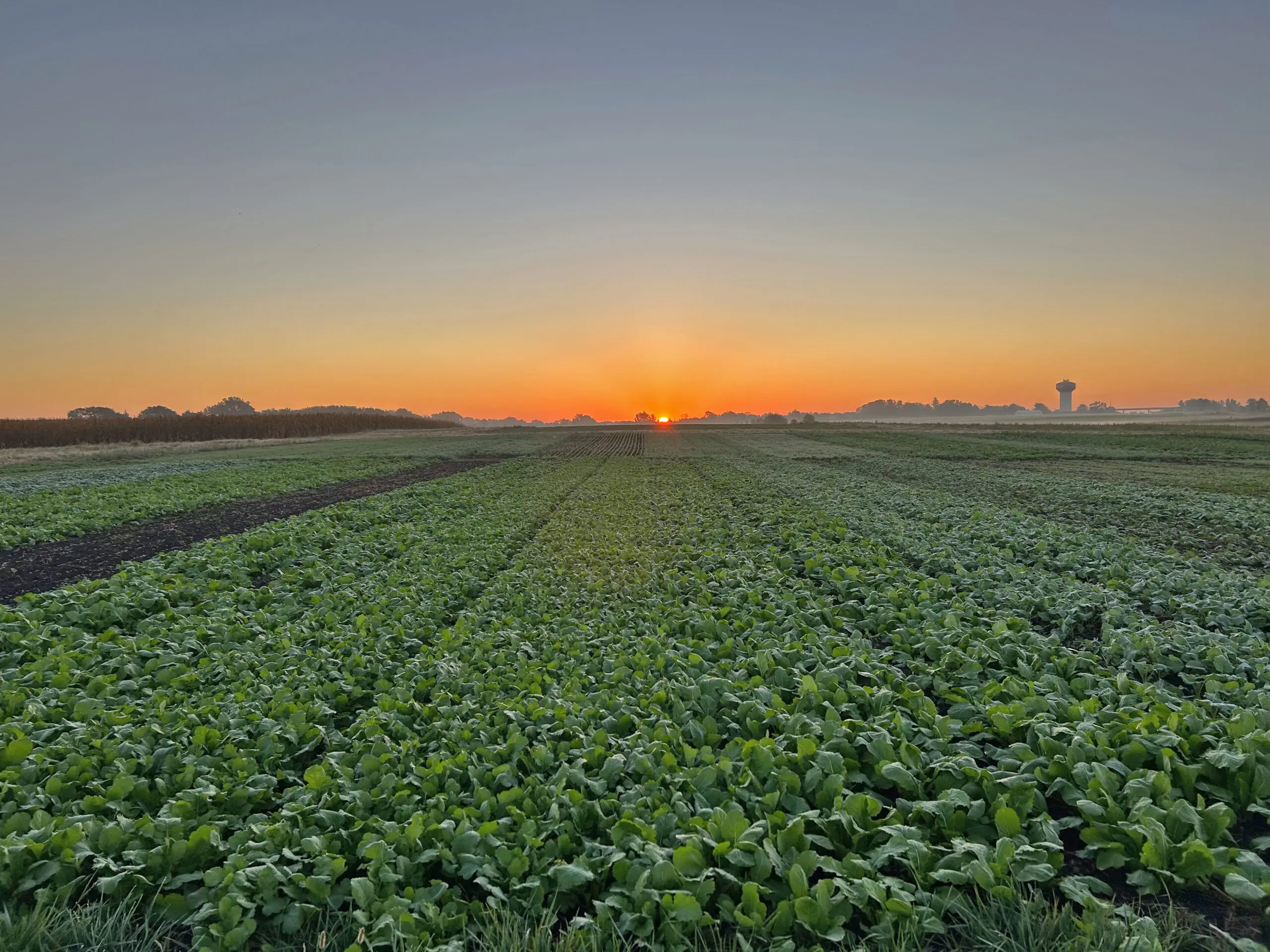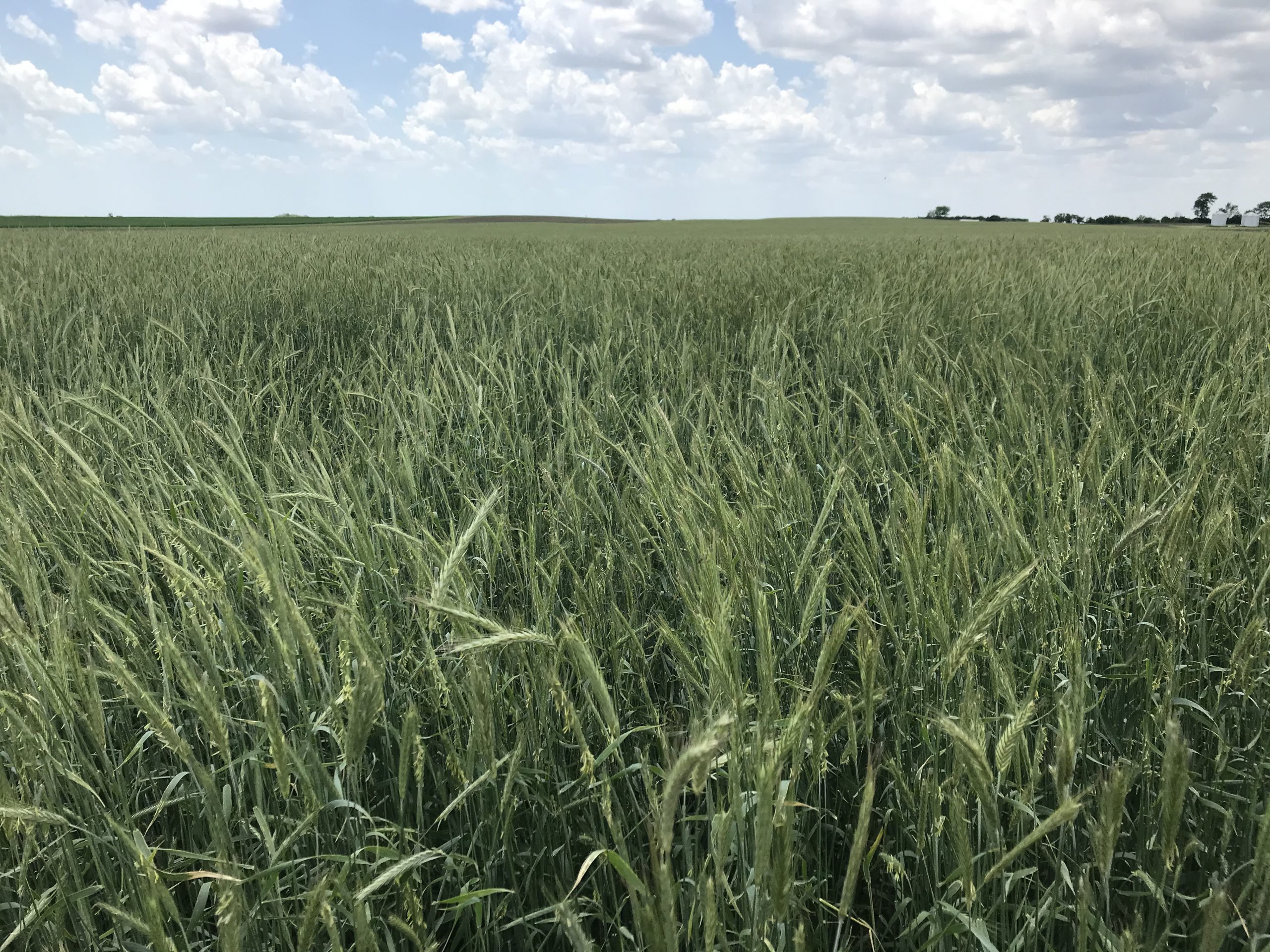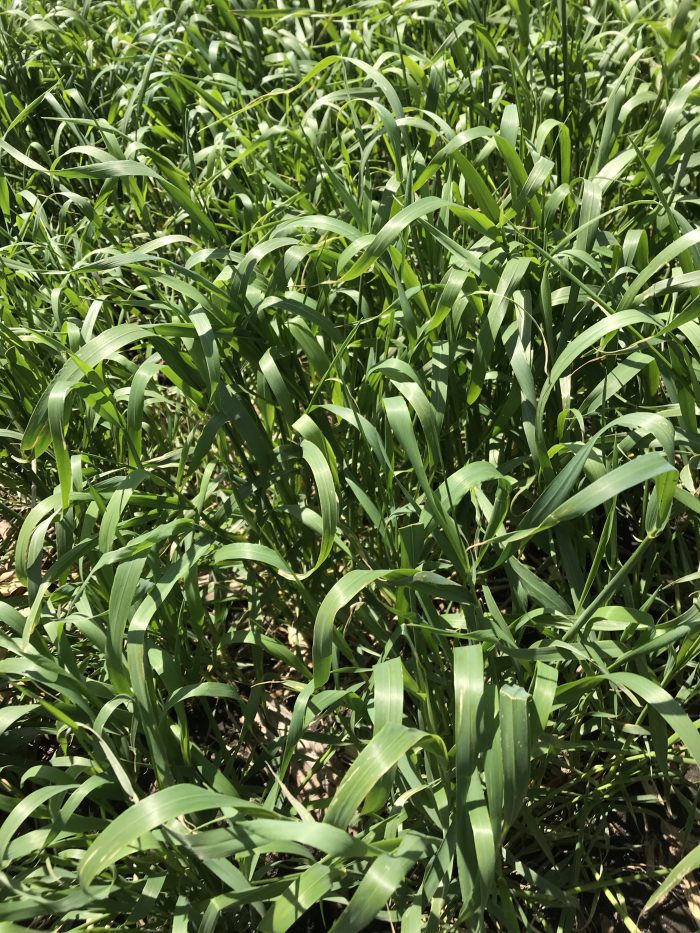by Margaret Smith, PhD ∙ Agronomist
- Tips for Rolling and Crimping Winter Rye before Organic Soybeans
- Decisions for Less-than-Ideal Conditions
Two neighbors in north-central Iowa are fairly new to organic farming and both experimenting with winter rye as a mulch cover for their transitional and organic soybeans. Both of their fields were planted last fall with the idea of planting soybeans this year and rolling and crimping the rye to terminate it and turn it into mulch to suppress weeds. Both farmers had planned to plant green into the rye as it reached anthesis (pollen shed) just before rolling and crimping to terminate it.
They each took a different approach, however.
Both farmers implemented some of the current guidelines for this practice, but neither implemented some critical ‘steps’ and, as a result, are facing challenges. Crop rotation; rye seeding timing, rates, and methods; soybean seeding rate and timing of rolling and crimping are all important factors to make this work! The first time out, most organic farmers try this practice following corn. Based on the recommended seeding dates, there is a huge challenge with this crop sequence. Overall, results in the Upper Midwest when rye for rolling and crimping was planted followed corn grain harvest have been poor.
On May 15, both Iowa farmers were faced with the decision of whether or not to keep their rye stand and move ahead with their initial plans to roll and crimp their cover crop and no-till plant their soybeans. Their operations and cover crop assessments are summarized here.
Characteristics of two Fall, 2019 winter rye seedings for organic cover crop, May 15, 2020 in north-central Iowa.
| Farmer #1: In organic transition | Farmer #2: Recently certified organic | |
| Previous crop | Corn | Corn |
| Rye Variety | Aroostook | Aroostook |
| Seeding method | Aerially, by airplane | Drilled |
| Seeding rate | 100 lbs/A | 3 bu/A |
| Seeding date | 1st week of September | October 30 |
| Nitrogen additions | none | 2,500 gal swine manure, knifed in following corn harvest (~ 100lbs/A N) |
| Rye stand evaluation, May 15 | Spotty irregular stand, characteristic of aerially seeding, both fall and spring tillers present | Very uniform stand Individual plants had two or three tillers, most formed in the fall. |
| Rye growth stage, May 15 | Beginning heading, irregular across field | Mid-boot stage |
| Rye height (influenced by cool spring temps) | 20″-26” | 18″-24” |
| Rye dry matter biomass | Not measured | 4,383 lb/A |
| Impact of May 8 frost | Fairly severe in low-lying areas. Damaged rye plants were delayed in development | No frost experienced on this farm |
| Prediction of success for weed suppression in organic soybeans | Poor. Rye plants too small and stand too irregular for adequate biomass production and distribution to form a uniform mulch. | Plants small and maturity delayed, but excellent stand with potential for further growth and biomass accumulation. Rye heading, rolling and crimping will be delayed and will delay soybean planting |
| Farmer’s decision | Planned to till down the rye and manage soybeans with full width tillage and post-plant, typical mechanical weed control practices for organic soybeans | Planned to maintain 15 acres of the rye seeding and plant soybeans ‘green’ before rolling and crimping the rye. Soybean planting will be delayed until early- to mid-June, based on rye development. |
Current recommendations for this have been developed, largely from work done at the University of Wisconsin by Dr. Erin Silva and her research team, work in the eastern U.S. by University and USDA-ARS researchers, and especially, to farmers’ experimentation and experience. The body of knowledge has increased immensely in recent years on how to best implement this system. The Rodale institute in Pennsylvania and U.W. Organic Program advise that 8,000 to 10,000 lbs /A dry rye biomass is need to adequately suppress weed growth in organic soybeans.
Current recommended practices for success with this system are:
- Variety selection: Researchers in Wisconsin and experienced farmers in the Upper Midwest have had success with the varieties Spooner, Aroostook, and Elbon. Other varieties may work and need evaluation (see resources, below).
- Drill plant rye in September in the Upper Midwest, ideally by September 15-20, up to September 30
- Plant rye following a short-season crop, such as oats, peas, sweet corn or silage corn to accommodate early planting. (Results following corn grain have been poor. This rotation/system may work with longer growing seasons in southern Iowa, central Illinois, and south.)
- Seed rye at 3,000,000 seeds/A.
- In the spring, roll and crimp the rye when 100 % of the plants are shedding pollen (at anthesis). (Because rye varieties are composed of diverse genetic populations, when last plants reach anthesis, some earlier plants will be more mature).
- Plant soybeans at the same time as rolling the rye. Some farmers have had better success getting seed into the ground by planting soybeans into the standing rye first and immediately rolling after planting. (Others have experimented with planting green about two weeks before rolling, with the objective to roll rye at anthesis when soybeans are between V1 and V3 growth stages. Disturbing rye with the planter can delay maturity and spread the time period to achieve 100 % anthesis. This planting window/timing has not yet been perfected).
- Plant soybeans in 30” rows at 225,000 seeds/A.
Some farmers drill soybeans, but then give up the option to run a single cultivator later in the season, if needed.
- For planting soybeans AFTER rolling and crimping the rye cover crop, add weight or down-pressure to the planter.
Based on my observations, open-pollinated, cover-crop rye needs some supplemental nitrogen source (legume N or manure) applied in the fall for best tillering and biomass production. Nitrogen rates have not been tested on rye in this scenario.
Best success with crimping and rolling rye will come by following the recommendations, above. With ongoing research and farmers also ‘pushing the window’ on this new practice, we can expect future refinements to these guidelines.
Resources
Cover Crop Rye: Rolling and Crimping
- Evaluating the Roller-Crimper for Cover Crops in Corn and Soybean Terraced Ground, North Central SARE
- No-till and Reduced Till Organic: Fact Sheets, Reports and Videos, University of Wisconsin Organic Program
- OGRAIN Fact Sheet Series 19-1 No-till Soybean Trial (2018), University of Wisconsin Organic Program
- Roller Crimping Cereal Rye Cover Crop Ahead of No-Till Soybean Planting: A Systems Approach, Purdue University
- Soybean Row-Width and Seeding Date When Using a Roller-Crimper for Cereal Rye Cover Crop, Practical Farmers of Iowa
Rye Variety Comparisons for Biomass Production
- Cereal Rye Suitability for Roller Crimping and No-till Applications, Iowa State University
- Winter Rye Variety Trials 2017 Results, University of Maine



